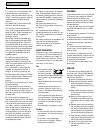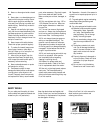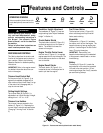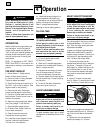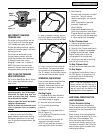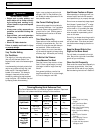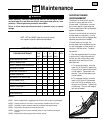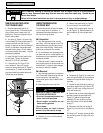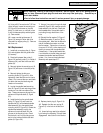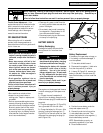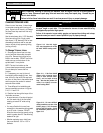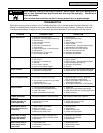
Vary Throttle Setting
For Conditions
The majority of trimming and mowing
jobs will yield the best results if the
engine throttle is set at the fastest engine
speed.
Less demanding jobs (and projects that
require very precise cutting) may yield
better results if the engine speed is
backed off somewhat. (For example,
damage to trees and shrubs can be
avoided by reducing the engine speed;
using the lighter .130" diameter line; and
by keeping a safe distance away.)
Again, once you begin a particular job
and get a “feel” for the conditions, you
will be able to make adjustments for the
best possible results.
Use Correct Walking Speed
Use a walking speed that is suitable for
the mowing conditions. You’ll get better
results at slower walking speeds if the
growth is tall or lush. Shorter grass or
less dense growth can be cut at faster
walking speeds.
Trim When Wet or Dry
Grass and most other materials are most
efficiently trimmed when dry. But, the
unit will do a fine job even with damp or
wet materials. When conditions are
moist or damp, be sure to clean debris
off the machine regularly to keep cutting
efficiency high. And watch your footing!
Do Not Let the Trimmer
Lines Become Too Short
Once the trimmer lines are worn to less
than 1/2 their original length, trimming
jobs begin to take far longer than they
should.
As a general guideline, once the line
length becomes half of its original length,
it’s time to change to new lines.
Use Extreme Caution on Slopes
When operating on sloping ground, use
extreme caution and common sense to
avoid possible injury or property damage.
Do not mow on excessively steep slopes!
Avoid slopes if greater than 15
0
or wher-
ever footing is unsure. If a slope is diffi-
cult to stand on, it is probably too steep
to trim or mow. In this case, it may be
wiser to establish a permanent ground
cover on this area.
Do not trim on slopes when the ground is
slippery. Trim across the face of a slope,
not up and down. Slow down and exer-
cise caution when changing direction on
slopes.
Keep the Mowed Side to Your
Right as You Move Ahead
The unit feeds cut materials to the right
side. Stay on the right side of unmowed
growth as you move along.
Clean the Unit Frequently
Clean under the mower deck frequently to
remove any grass buildup. Also clean
around the muffler and on top of engine.
See the cleaning instructions in Section 5.
10 Section 4: Operation
Cutting Line Throttle Walking
Height Diameter Speed Speed
(Note 1) (Note 2) (Note 3) (Note 4)
Any
.130" or .155"
Fast Any
Light Growth
(Note 6)
Start high,
.130" or .155"
Tall Growth
progressively
(Note 6)
Fast Slow Pace
lower
Heavy/Tough
Any
.155"
Fast Slow Pace
Growth
(Note 6)
Trimming
.130"
Near Trees Any
(Note 7)
Slow Slow Pace
and Shrubs
(Note 5)
THROWN OBJECT HAZARD
• Objects such as rocks, pebbles, and
small debris will be thrown violently
by the cutting head, resulting in sig-
nificant hazard to eyes and exposed
body parts.
• Always wear safety-approved eye
protection and suitable clothing and
footwear.
• Keep children, pets and bystanders
50 feet away from machine while
operating.
• Be alert to hidden obstacles.
Failure to comply could result in injury
or property damage.
WARNING
NOTES:
1. See “Adjust Line Cutting
Height.”
2. See “Use Correct Diam-
eter Trimmer Line.”
3. See “Vary Throttle Setting
For Conditions.”
4. See “Use Correct Walking
Speed.”
5. See “Tips for Precision
Cutting.”
6. See “Changing Trimmer
Lines” in Section 5.
7. Lighter line helps prevent
damage to bark.
CONDITION
Trimming/Mowing Quick Reference Chart
This Quick Reference Chart is provided as a general reference. Experiment
with your unit to determine the best settings for the conditions.



